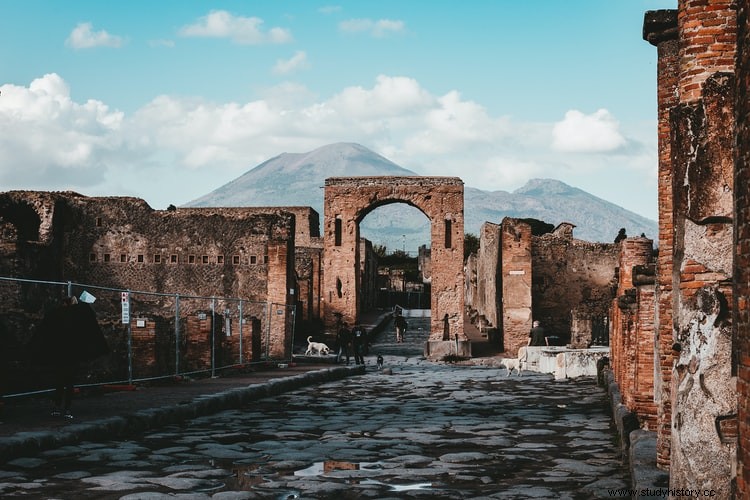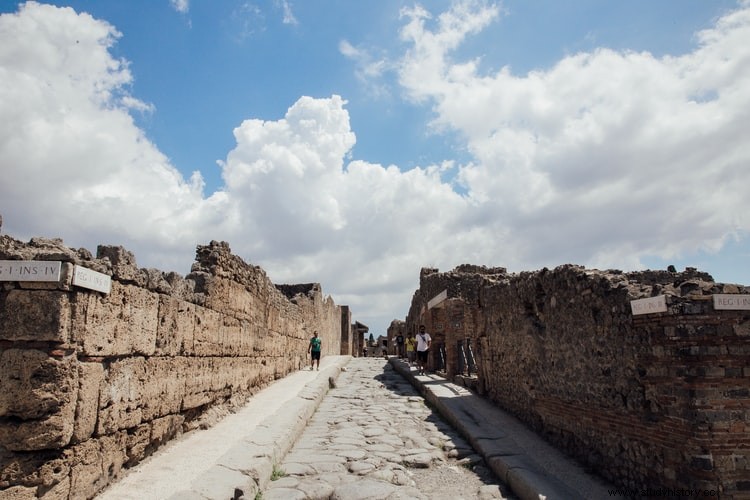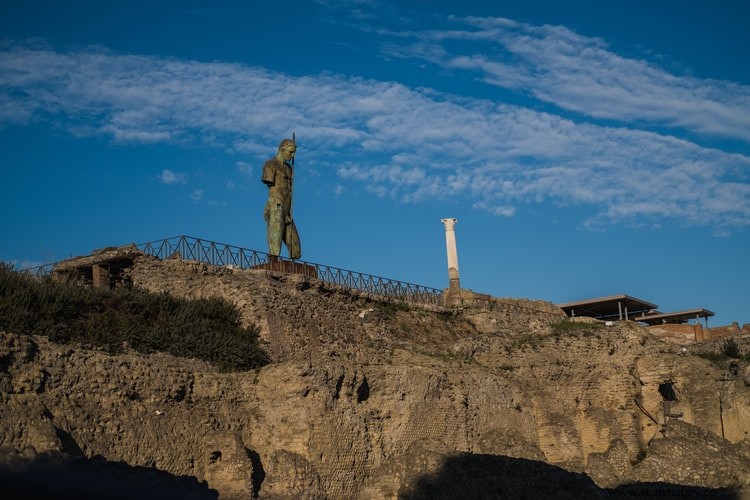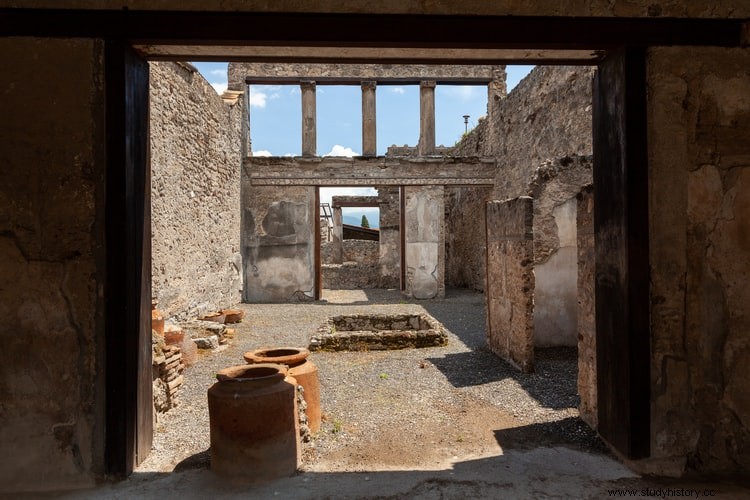This sophisticated Greco-Roman city of Pompeii would leave you amazed. Moreover, this ancient Roman city is located to the southeast of Naples. Further Due to volcanic eruptions from Mount Vesuvius, the city in the southeast was destroyed. Furthermore, the city remained covered in ash for ages until it was excavated in 1700. After excavation, the remains of an ancient Roman city were revealed. Pompeii was only fourteen kilometers from Naples, and existed in Campania, Italy, and became a top tourist destination.

How Pompeii Emerged
Indeed, ancient Roman city remains were preserved to perfection despite being buried under a pumice stone and ash. The destruction occurred due to a large volcanic eruption of Mount Vesuvius nearby. In August 79CE, this eruption occurred and left a tragic condition for the inhabitants of the city of Pompeii. As a result of the volcanic eruption, nothing was spared. The buildings, roads, people etc. whatever got in the way were buried under the lava.
Know about Pompeii
The ancient Roman city housed ten thousand to twenty thousand inhabitants at the time of its destruction. The city was built on a track created by a lava flow in the prehistoric period. The trail of the lava flow ended at the modern river Sarno. In addition, three more communities were destroyed by lava flow in Stabie, Herculaneum and Torre Annunziata. However, in 1997, along with Pompeii, all three were declared a World Heritage Site. The modern city, the Comune, arose on the eastern zone. Due to the presence of the Basilica of Santa Maria Del Rosaio, the city has further gained a reputation. It has achieved pilgrimage values.
What all got unearthed in Pompeii?
After the lava erupted, toxic gases, ash and pumice engulfed the city. Buildings with residents inside were suffocated. Moreover, those who tried to flee were crushed. Since then and for centuries, Pompeii remained dormant under lava debris. In 1700 when the old Roman city with Greco-Roman features was rediscovered in almost perfect condition. The majestic villas, buildings, forums and human remains revealed the daily routines of human livelihood. The people around were amazed. The remains were so realistic that a loaf of bread in an oven was intact.
Historical background of Pompeii
The Neolithic people of Campania who spoke the Oscan language were ancestors of the inhabitants of Herculaneum, Pompeii and Stabiae. A study carried out by archaeologists suggests that the Oscan village located near the river Sarnas was influenced by the Greeks in the 8th century BC. Further in the 7th century BC the Etruscans entered Campania. In fact, strong influence of the Eutrascans remained until they lost their power at sea. King Hiron I lost a battle at sea. He ruled Syracuse. He lost the naval battle in 474 BC, off Cumae.
Then, after the decline of the Eustascans, the second phase of Greek influence returned. Consequently, at the end of the 5th century, the Samites, an Italian tribe, conquered Campania. Along with Pompeii, Stabia and Herculaneum became Sami cities.

Rome's allies with Pompeii
The Roman fleet arrives at the port of Sarna to attack Nuceria. The Second Samnite War took place. In 310 BC tried Rome, but unfortunately lost the battle. Accordingly Pompeii came to the limelight. The Sarna port belonged to the ancient city of Campania. After the end of the war, Campania combined with the Roman confederation together with the cities. However, the complete romanization took place during the Social War.
How Pompeii Got Excavated
The famous archaeologist Dominico Fontana in the sixteenth century discovered the ruins of Pompeii. Furthermore, based on an inscription discovered in 1763, identification of the city was possible. Furthermore, the excavation work actually started in 1748. Modern science of archeology began in the middle of the 18th century. Karl Weber, a military engineer, originated the ritual of systematic study between the period 1750-1764. The then King of Naples, Don Carlos, supervised the work. But the first excavation was accidental. Furthermore, educated workers, theft of valuables, stopped digging in 1860.
Then an Italian archaeologist, Gieuseppe Fiorelli, started as excavation director, who did a good job of restoring and documenting every find in the Pompeii ruins. However, due to the Second World War, excavation work stopped. However, the excavation was restarted at a rapid pace by Amedeo Maiuri. Between 1749-782 discovered twelve villas in the neighboring towns Carlos the King of Naples. In the 20th century, almost two-thirds of the ruins could be excavated in Pompeii.
City plan in Pompei, we come to learn
Due to the prehistoric lava flow, you can find irregularities in the city of Pompeii. Fortunately, the remains could be restored in perfect condition. However, there is a conflict of ideas between the scholars and what facts have emerged after excavation. While the south-western part of the city appears to be the oldest. But the scholars do not accept. A two kilometer long wall surrounds a plot of land of 163 acres. In addition, seven gates were excavated at the city's borders. The important roads run in a northwest-southeast direction. These roads also connect the city with the neighboring towns. The Visuvius Gate is located at the highest point, that is forty-four meters above sea level. While the Stabie port is at its lowest ie8 meters above sea level. The Stabie gate is the one from which the main traffic from the river Sarnus and Stabie enters.
What all remained after excavation
If you visit Pompeii, you can find public buildings separated into three zones. The forum is located in the southwest with a view over the bay. While the amphitheater and Peletra in the east and west.
- The city's center for municipal operations was the Forum's location. This triangular forum was known for religious activities as well as economic discussions.
- Many temples can be found around the forum.
- Doric temple is the oldest temple in Pompeii, located on the forum itself
- Temples such as Zeus Meilichus, Isis and the Samnite age palaestra were nearby
- The amphitheater is on the eastern corner of the city
- A large palaestra lies to the west of the city
- Many baths are spread across the city. Even personal luxury houses have bathrooms too.

Variation in art form
Art found in public buildings inherits structural art forms of Italian and Roman type. However, the luxurious private houses in the neighboring towns are more attractive. Especially those built in the third and fourth centuries, i.e. the period of Samnite I.'s reign. The Surgeons' House is the best example of that era. Furthermore, under Samnite II, further magnificent private houses were built. During two hundred and eighty B.C. Refinement of art forms took place. During this period trade and cultural influence gave rise to a Hellenistic influence.
An example is the House of Faun, which covers an entire city. It's huge. The building consists of two large chief's rooms, four dining rooms and two large gardens. The building was built of gray obtained from Nuceria. House of Faun owns the lost Hellenistic painting of Alexander the Great. It was copied and at the same time placed as a mosaic. In the same way, many other houses were decorated. Consequently with beautifully designed floral painted mosaics.
Second Pompenion architecture
The first ever Pompeii wall decoration can be seen in the House of Faun. Marble with stucco paint adorned the walls of the building. The high-column, atrium-style wedding House of Silver was also built during this time. However, the atrium was renovated in later days. During the period when the second Pompenion architecture became popular. It remained popular from eighty BC. to fourteen AD Exedra the beautiful banquet has been decorated with other Pompeian style.
No new private houses were built in Roman times. All those built in the contemporary era. The excavators tried to preserve the smallest details of the ancient city. The meaning of wealthy or common people was no different. The excavators tried to keep the roof, stories and even balconies for visitors to glimpse.
Impact on European culture
A great impact on European taste was stirred by the news. The news of the excavation of Pompeii and its neighbors below the Vesuvius eruption had a great effect on Europeans' enthusiasm and interest. News of the excavation success spread like wildfire. The renowned German classicist Johan Joachim Wnkelmann's high appreciation and visit to Naples in 1755. The etching by Gaimbattista Piranesi added promotional influence to excavated sites. In addition, Pompeii, Herculaneum and Naples began to attract English visitors.
Inspirational aspects of Pompeii
The excavations in Pompeii and the nearby cities inspired many trade problems. Admirers of various professions began to follow the aspects of the ancient city. The transition of one cultural aspect began to change into another.
- Ceramists, artists, archaeologists beyond furniture manufacturers
- Wall paintings with frescoes found in excavations inspired interior decorators
- Stucco art became popular in Great Britain in the 18th century. It was James and Robert Adams
- The excavations of Pompeii inspired to a neoclassical art form. Furthermore, it completely replaced the Rocco style of art that was popular during the time of Napoleon and the French Revolutions
- Motives from buildings all over Europe were inspired by the excavated remains.
- Social, political, religious etc. for an old city
- Industrial provisions available at that time in factories.
- The representation of the process of preparing staple foods in the bakery

Benefits from inscriptions
Even if you do not hire a guide, the inscriptions on temples, status and monuments will explain what is their profile. The famous wax tablets were one of a kind. Furthermore, the wax tablets had inscriptions of games, political events, etc. In addition, the graffiti inscriptions help you realize what announcements were made daily for the benefit of the residents. In addition, the excavation revealed architectural and epigraphic details of the ancient city. Furthermore, there is evidence that reflects the social structure. Gives you an idea of social stratification between rich and poor. Also, aristocrats to then Roman aristocrats.
Points of concern
In recent times, the excavation site has been threatened. The reasons have undoubtedly created worrying things. The harshness of the weather, visitor traffic and growth in vegetation have created a mess. Restoration work of excavated parts of Pompeii have been carried out at intervals by experts. But they don't seem fertile. Due to deterioration, vandalism and mishandling, the Italian government became concerned. Furthermore, in 2008, he took the initiative to restore the valuable remains of the old city. A one-year state of emergency was declared. Furthermore, an expert commissioner was assigned to oversee the situation.
Tips for visitors
Those of you who want to visit the Pompeii excavation site. Explore the intricate art, designs and architectural splendors of the old city. You can reach this cultural monument by air, i.e. by plane, train, bus or train. Furthermore if traveling from Capri, use waterways to reach Naples. Furthermore, the best part of the journey can be by bus. The car or the car.
- Pompeii does not have its own airport. That's why you need to take a break. Either from Naples or Rome. The train station you need to reach Pompeii Scavi. The entrance to the excavation site is only fifty meters from the station if you use the train.
- Reaching Pompeii by bus is also available. Furthermore, local buses go up to Pompeii. Furthermore, these buses have SITA. You can ride one of them from Nuvo Marina and reach your destination. The price for the bus is 2.8 euros
- To enter the excavation sites in Pompeii, you need tickets. The criteria are
- Full price is 11 euros
- The discount is 5 euros for people between 18 and 25
- For under 18s tickets are free

the conclusion
If you believe in the concept, seeing is believing. If you want to know a UNESCO-recognized heritage site, Pompeii is definitely a historical place to check out. This ancient city's architectural structure has survived many wars and the natural disaster of the volcano. It is something of great beauty and nostalgia. Fortunately, after excavation, the remains have provided technical, structural and architectural insights into ancient history and life.
